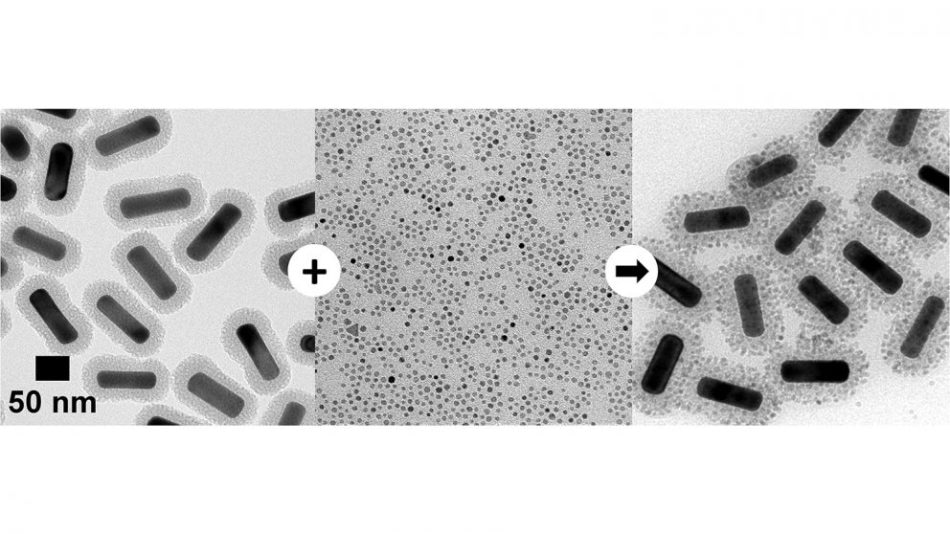Dec 12 2017
Researchers from MIT and North Carolina State University have discovered a more simple method to deposit magnetic iron oxide, or magnetite, nanoparticles onto silica-coated gold nanorods, making multifunctional nanoparticles with useful optical and magnetic properties.
 Mixing silica-overcoated gold nanorods (left) and iron oxide nanoparticles (center) yields iron oxide-overcoated gold nanorods (right). Credit: Brian Chapman.
Mixing silica-overcoated gold nanorods (left) and iron oxide nanoparticles (center) yields iron oxide-overcoated gold nanorods (right). Credit: Brian Chapman.
Since gold nanorods have a surface plasmon resonance, meaning that they can absorb and scatter light, they have widespread potential applications. It is possible to control the wavelength of the absorbed light by controlling the dimensions of the nanorods, particularly their aspect ratio (or length divided by diameter). This feature makes gold nanorods attractive for use in security materials, catalysis, and a range of biomedical applications, such as cancer therapy, diagnostics and imaging. The fact that the magnetite-gold nanoparticles can also be controlled employing a magnetic field improves their potential usefulness for biomedical applications, such as photothermal therapeutics or diagnostic tools.
The approach we outline in our new paper is simple, likely making it faster and less expensive than current techniques for creating these nanoparticles – on a small scale or a large one.
Joe Tracy, Associate Professor, Materials Science and Engineering, NC State
The new method uses an approach known as heteroaggregation. Silica-coated gold nanorods are dispersed in a polar solvent, ethanol. The hydrogen atoms are partially positively charged, while the oxygen atoms are partially negatively charged in ethanol. The magnetite nanoparticles are dispersed in a non-polar solvent, hexanes, where the charges are not separated. When these two solutions are mixed together, the magnetite nanoparticles bind to the gold nanorods and the resultant magnetite-gold nanoparticles are removed from the solvent through a simple centrifugation process.
We are able to take pre-synthesized, silica-coated gold nanorods and iron oxide nanoparticles and then combine them. This is simpler than other techniques, which rely on either growing iron oxide nanoparticles on gold nanorods or using molecular cross-linkers to bind the iron to the silica coating of the nanorods.
Brian Chapman, a Ph.D. student, NC State
“Our approach also results in highly uniform nanoparticles,” Tracy said. “And by incorporating ligands called PEG-catechols, the resulting nanoparticles can be dispersed in water. This makes them more useful for biomedical applications.”
These are interesting, and potentially very useful, multifunctional nanoparticles. And hopefully this work will facilitate the development of applications that capitalize on them.
Joe Tracy
The paper titled “Heteroaggregation Approach for Depositing Magnetite Nanoparticles onto Silica-Overcoated Gold Nanorods” is published in the Chemistry of Materials journal. This paper was co-authored by Qiaochu Li and Niels Holten-Andersen of MIT; and Wei-Chen Wu, a former Ph.D. student at NC State. This work was supported by the National Science Foundation under grants DMR-1056653, DMR-1121107, and CBET-1605699.